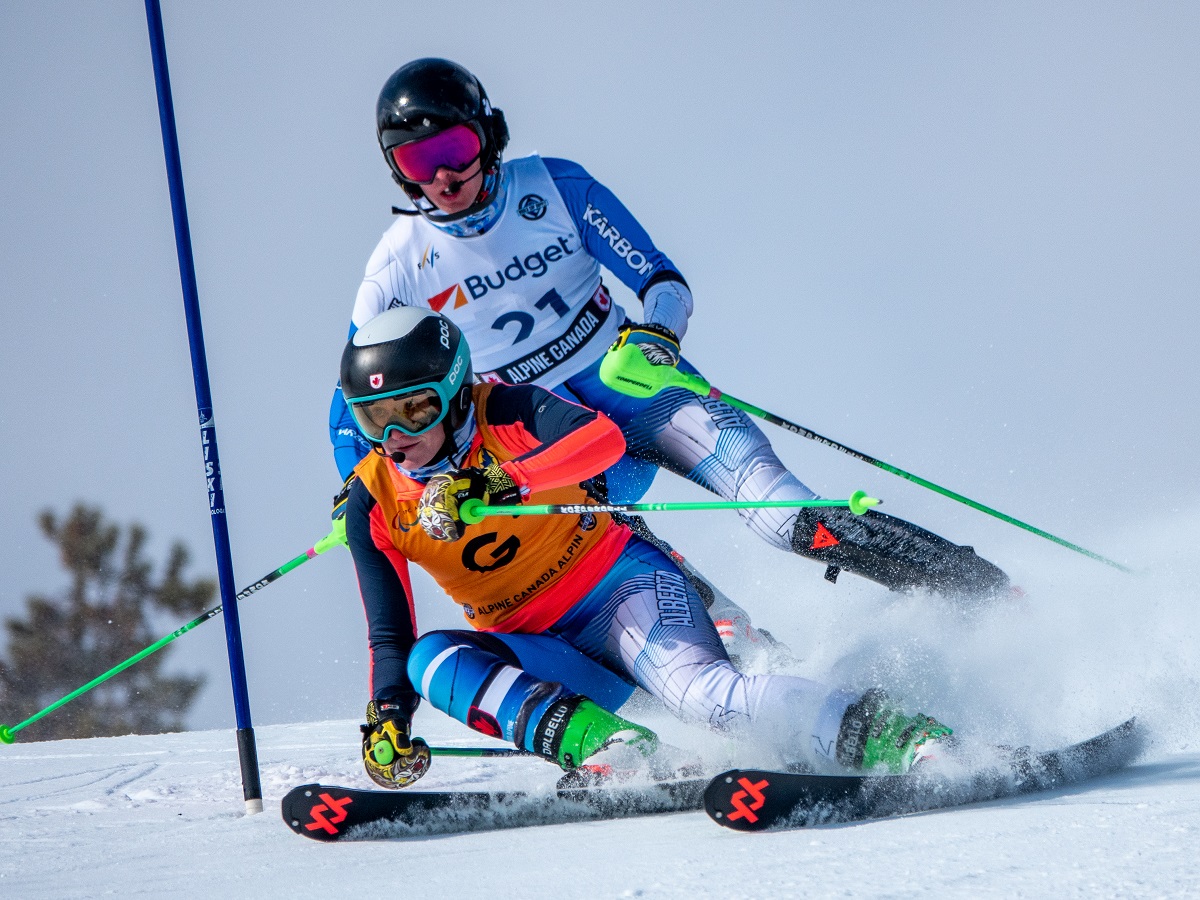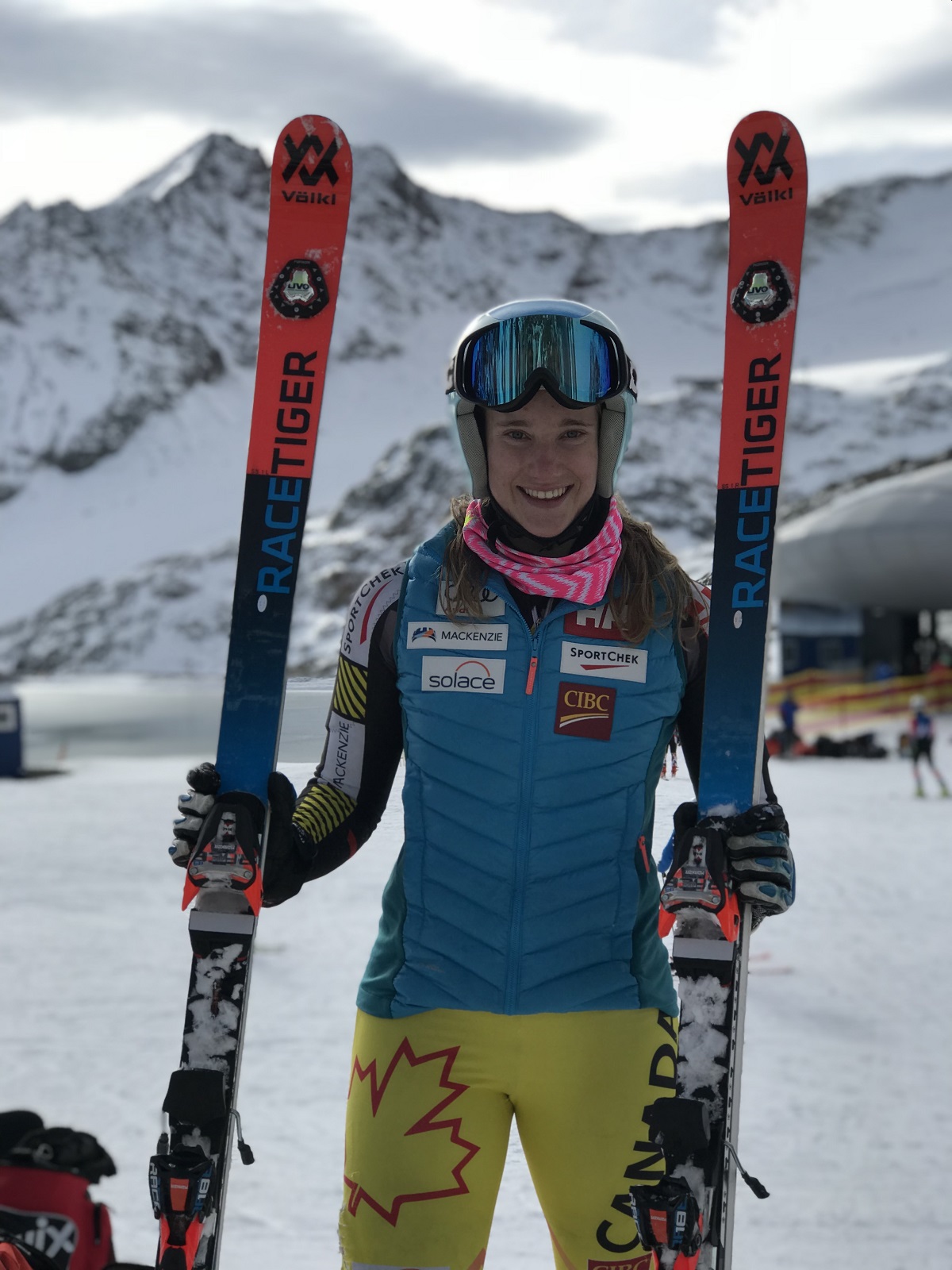In her teens, Ottawa native Sierra Smith was a downhill phenom, but knee injuries ended her Olympic quest. Now she’s back on course for Italy 2026, this time as a guide for visually impaired skier Kalle Eriksson.
In some snow sports, bumps are a good thing. Not, however, when they get in the way of your downhill dreams.
For Ottawa born and educated Sierra Smith, the slopes to national-level ski-racing glory have been a bit too bumpy. Several years ago, she made the agonizing decision to abandon her dreams of competing at the Olympics. Now, though, she’s pursuing them again on a slightly different route. Sierra is a poster girl for the mantra “Never give up.”

Born into an Ottawa ski-racing family—her mother and grandfather were both on the Canadian national team, Sierra was a late starter. In a sport where keen athletes are training multiple times weekly and racing most weekends by the age of 10, she had never skied more than a few days annually on family ski holidays, because she lived in Paris. But at age 12, she returned to Canada and jumped right in. “I’d always wanted to ski race,” she recalls, “so my parents signed me up to Club Mont Ste. Marie.” It didn’t take her long to catch up to the pack. Within a year she was winning local races, within two years she was beating all the boys. Within three years, it became obvious Sierra was the standout skier of the region when she won a silver medal at the North American U14 championships. By her U16 years, she was on the podium in every race she finished. She also qualified for the prestigious Topolino race in Italy.

In 2017, at age 17, she was called up to the Canadian team. As soon as she finished high school at École Secondaire Publique Louis-Riel, she headed west to Calgary, where the team is based. She spent weeks in the gym before the first on-snow camp in June. By December 2017 Sierra was ready to race. But disaster struck in her first one, a downhill at Lake Louise. She had a horrific fall and tore her ACL, MCL and meniscus. Basically, she ripped apart her knee. Dejected, she returned to Ottawa where she had surgery January 2, 2018.
Knee injuries are among the most common for ski racers. The knee joints have to withstand enormous mechanical stress as skiers carve through ruts, ice and soft patches and hit the occasional bump. While a knee injury typically takes a least a year to heal, with countless hours spent in the gym and in physiotherapy, some of the best skiers on the World Cup circuit have returned from this type of injury. So Sierra worked at recuperation for over a year, returning to racing in February 2019 at Georgian Peaks, Ontario, where she tore her knee again and was promptly cut from the program.

She joined the Quebec ski team to start on another round of rehab through 2019 and 2020. But the onset of lockdowns for COVID shut down the 2020 season and, three ski seasons out from her last race, she decided to quit the elite levels of the sport to get on with life.
Accepted into the kinesiology program at the University of Calgary, Sierra started coaching the U of C DINOS ski team. Then in 2022, Para Sport International, a feeder team for the Canadian paralympic team, was looking for a female coach to help in the gym. Sierra signed up. She met Kalle Eriksson, a visually impaired skier in his first year of racing.
Kalle had lost his eyesight in April 2020. He was with his father, at that time a coach for the Swedish paralympic ski team, in northern Sweden. “I had no helmet, no goggles and it was super sunny,” he recalls. “The reflection from the sun burned my retina.” Kalle was left with eight per cent peripheral vision. He describes his sight as if he has two bunched fists in front of his face at all times.

When Kalle and Sierra met, he had no guide. Sierra offered to ski in front of him until he found one. “Then I tuned my skis, then I put my skin suit on,” she recalls. “Then I offered to be his guide.” The pair set off for the Canada Winter Games in P.E.I. in early March 2023. They competed in giant slalom and slalom and won both races by “about 30 seconds,” says Sierra. Next up were the U.S. and Canadian Nationals in Kimberly B.C. where they competed in two super G races (more speed, fewer gates), two giant slalom races and two slalom races. Once again they won everything, automatically qualifying for the Para World Cup circuit for this upcoming season.
What next? Once Kalle gets his para certification—all para-athletes must undergo observation to judge their level of disability—the pair will head to Europe to join the World Cup great white circus when the snow flies. Until then, they’ll be working out in the gym together. “I feel like we should be more stressed,” says Sierra, “but I have so much trust in him behind me.” That said, it’s not quite like ski racing tag. In slalom, Sierra cannot touch any gates because they might bounce back and hit Kalle in the face, so she’s had to change her skiing to do the job.
She skis more now with her mind and her voice, “because I verbalize everything as I’m going. I say what I see, what I feel, I tell him about big ruts, turns that are tighter or wider than we expected during inspection, I tell him about shadows, when I’m going into and out of a tuck position.” In giant slalom it is easier for Sierra as she spends a fair amount of time standing up looking where Kalle is behind her: more than three gates back and the pair is disqualified. But for Kalle, it’s harder to see the gates in GS, so he relies more heavily on communication and keeping his peripheral vision on Sierra.
Communication is via motorcycle headsets with boom microphones that are helmet mounted. But occasionally they come a cropper, knocked off by a rogue gate. They’ve had a couple of close calls—once when Kalle fell, didn’t say anything and came sliding fast down behind her—but no dual wipeouts yet. From Kalle’s perspective, the loss of sight has meant he’s become much more body aware.
While it’s a very new partnership, the pair has garnered several equipment sponsors to help with the costs of this expensive sport. Volkl skis, Marker bindings, Dalbello boots, POC helmets and goggles and Level 7 gloves are all outfitting these athletes who have their sights set on the Winter Paralympics in Cortina, Italy, in 2026. They have also set up a fundraising campaign at inspireme.fund
Go Canada!
